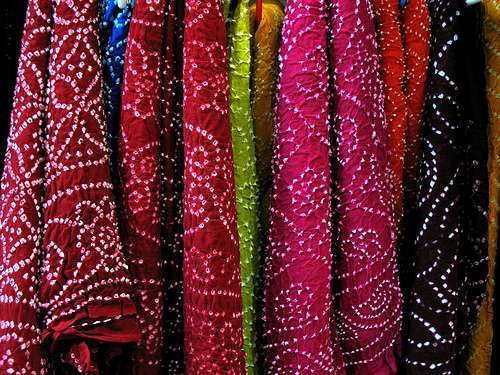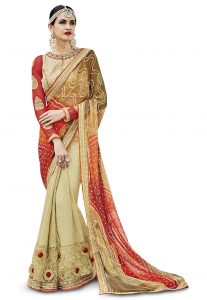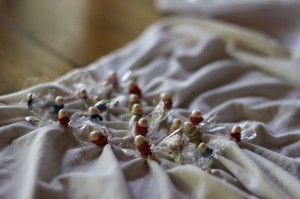
Bandhani or Bandhej
Bandhej, also known as Bandhani, is a tie and dye method practiced mainly in states of Rajasthan, Gujarat and parts of Uttar Pradesh. The word Bandhani is derived from a Sanskrit word Banda which means “to tie”. Bandhani is truly an art that involves dyeing a fabric tied tightly with a thread at several points, producing a variety of patterns.
History
Bandhej is the oldest form of tie & die art which began about 5000 years ago. As per the historical evidence, the first Bandhani saree was worn at the time of Bana Bhatt`s Harshacharita in a royal marriage. One of it’s earliest visual representations can be seen in the Ajanta caves. In India, Bandhani work was started by the Khatri Community of Gujarat. Places in Rajasthan like Jaipur, Sikar, Bhilwara, Udaipur, Bikaner, Ajmer, and Jamnagar in Gujarat are the well known centers producing odhnis, sarees and turbans in Bandhani. It is an ancient form of art which is still in practice.
Technique
The art of Bandhani is as exciting as it’s history. The fabric to be dyed is tied very tightly at different points in knots and then dyed with extraordinary colors. When this tied cloth goes for dyeing, these threads or knots doesn’t let that part catch color & allows it to stay white or whatever color the cloth has. Once the cloth is dyed, it is left for drying in open air. Drying can take some time depending upon the weather conditions. In monsoon, it takes around 2 days to dry while in summer it takes only 4-5 hours. In winter it takes around 6-7 hours for drying.
Style & Variety
Bandhani comes in a variety of colors, designs & patterns and these variations are region specific. The colors that are most prominently used in Bandhani are yellow, red, green, blue and black. After the processing is over, Bandhani work results into a variety of symbols including dots, waves, strips and squares. The patterns include Leheriya, Mothra, Ekdali and Shikari depending on the manner in which the cloth has been tied.
The outfits comprise Khombi, Patori, Gharchola and Chandrokhani. Bandhej work can be seen on Sarees, Kurtas, Salwar kameez, and Chaniya cholis. The designs include Ekdali (single knot), Trikunti (three knots), Chaubandi (four knots), Dungar Shahi (mountain pattern), Boond (small dot with a dark center), Kodi (teardrop shaped) and Laddu Jalebi (Indian sweets). Different colors transmit different meanings in Bandhani.
Wearing the Attire
Simple Bandhani Salwar Kameez are an everyday wear for many. Sarees with Leheriya patterns are usually worn for day-time ceremonies whereas Ghatchola lehengas & sarees are worn for occasions at night. Bandhej dupattas with plain white Salwar Kameez are very popular among young girls. Bandhej Sarees can also be worn by working women for a perfect style statement, yet keeping it subtle.
Global Appeal
Bandhani is truly an art and it’s a common sight to see not only women wearing outfits of Bandhej but also the men can be found wearing turbans with Bandhej motifs. The main market is in Gujarat but it is being sold all over India as the demand has increased over the past few decades. The sales shoot up during the wedding and festive seasons. Mostly, it is used as odhnis by the ladies on festivals.
Maintenance
The strength of Bandhani is lost if ironed with a high heat setting, therefore, it is advisable to get your Bandhej apparel dry-cleaned and if needed be, ironed with a low heat setting.
References
Categories: Motifs & Embroideries


